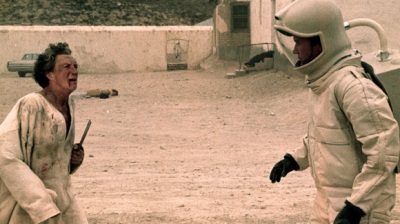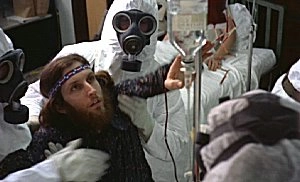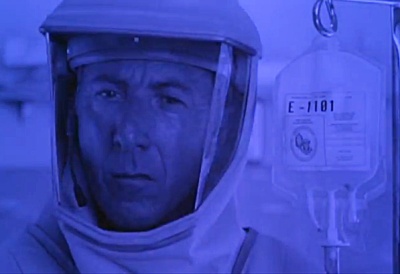Modern horror films boast a unique and not all together comfortable relationship with television. For a generation of movie brat directors like Spielberg, Dante, Carpenter, or Hooper, the television represents, on a basic level, the avenue through which clips of favorite old movies make it into a new generation’s works of art.
In films such as Halloween (1978), Halloween 2 (1981), Gremlins (1984), and Gremlins 2 (1990), for instance, “old” or “classic films” appear in the body of the new work, thus serving as an important reference point to the action. The appearance of these beloved Hollywood gems could be a simple way of paying tribute to the “greats.”
Or, on a more meaningful level, the productions that appear on the television sets in these horror films could boast a more complicated, inter-textual relationship with the new work.
For example, in Halloween, little Lindsay watches a horror film marathon that consists of such classic gems as Howard Hawks’ The Thing (1951) and Forbidden Planet (1956).
Both of these classic films, in some significant manner, relate directly back to the theme of Halloween. In the case of The Thing, a scientist tries in vain to understand the malevolent alien creature, only to realize (with fatal results…) that it is an implacable, nearly unstoppable monster. Similarly, in Halloween, Michael Myers cannot be diagnosed by science, but instead must be dealt with as a force of super-nature. He’s the Shape, or the Bogeyman.
Forbidden Planet, of course, concerns “Monsters from the Id” (the human subconscious), and there’s a line of critical thought that Michael, in Halloween, represents a manifestation of Laurie’s Id. She wishes for a man to have all to herself (as she sings), and Michael appears in the foreground of the frame almost simultaneously. Soon he is killing everyone that Laurie knows, setting up a relationship of bizarre exclusivity between them, just as the song portends: “just the two of us.”
In both instances, the nature of the film featured on the TV in the horror marathon relates to what seems to be occurring on-screen. This idea is even extended (as a wicked joke) in the 1981 theatrical sequel. After impossibly surviving six point-blank bullet shots, Michael continues to walk…and kill. On the television: George A. Romero’s Night of the Living Dead (1968).
In both Gremlins (1984) and Gremlins 2 (1990), director Joe Dante uses films playing on TV such as Rambo: First Blood Part II (1985) not as reflections of the movie’s themes, but as in-text influences on Gizmo’s growth as a warrior against the other Gremlins. Gizmo watches TV (to his owner’s chagrin), and begins to imitate the heroic behavior he sees championed by the likes of Clark Gable or Sylvester Stallone. In this case, movie history affects the shape of the narrative, creating “teachable moments.”
Importantly, Dante also highlighted moments from the original Invasion of the Body Snatchers (1956) in Gremlins to telegraph the important action of his story. Very soon, Kingston Falls (like the film’s Santa Mira) would become the fulcrum of an invasion by monstrous creatures.
The specific footage seen in Gremlins is from Body Snatchers’ climax, during which Dr. Bennell (Kevin McCarthy) warns passersby on a highway (in vain) that the aliens are already here; that the threat has commenced. Coming where it does in the story of Gremlins, his warning is just as important to unaware Kingston Falls. The Gremlins have arrived (and the rules governing their behavior have been broken.)
Many of the same horror movie directors have utilized the television as a portal of evil, one that sits right near the family hearth, in the American living room.
This was the underlying premise of Hooper’s Poltergeist, which saw “The TV People” (really ghosts) invade our reality. In one very funny moment, Mom Freeling (JoBeth Williams) implores her daughter Carol Anne (Heather O’Rourke) not to look at the static on the television set. She flips the channel to a station playing a violent war movie instead.

This disturbing cinematic imagery, ostensibly, won’t damage Carol Anne’s “sight” as much as the static.
Poltergest’s brilliant last shot sees the imperiled Freeling family kick a “dormant” TV set out of their hotel room, and then a long, slow camera retraction away from the offending appliance. The implication being that the family would be safe so long as it eschewed…tv watching.
Halloween III: Season of the Witch (1982) involves television on an even more fundamental, critical level. Here, a malevolent inventor, Cochrane (Dan O’Herlihy), plans to send a signal across America’s television sets that, when transmitted, will kill a wide swath of innocent children as a Halloween “prank.” Once more, TV is an avenue for absolute horror and destruction, a social critique, perhaps of the very form. Does TV destroy children’s minds, literally?
In 1988, director John Carpenter went even further in They Live. He began to see widespread “brain death” in America and he attributed it, in part, to the pervasive nature of television in our society.
Here, aliens beamed a hypnotic signal through the nation’s TV sets, one that would lull people into a trance so they would not notice when Yuppie aliens began lapping up all the resources, all the wealth, even all the good-looking women. TV was viewed, literally, in They Live as the opiate of the masses. And the “sound bytes” of politicians — hopelessly vapid platitudes — were part of the “lulling” effect.
In some fashion, Wes Craven’s Shocker (1989) built upon Poltergeist’s example and introduced a serial killer, Horace Pinker (Mitch Pileggi) who could enter and exit from the “TV world” into different victims’ homes.
The film’s final, stunning, tour-de-force chase through cable television programming gave new meaning to the term “channel surfing.” An example of Craven’s brilliant eye for “rubber reality,” Shocker was perhaps the ultimate in the horror film’s commentary on the dangers of television.
In the 1990s, references back and forth between filmmakers became sort of “in jokes” in many horror films. Kevin Williamson and Wes Craven featured a clip of Halloween in Scream (1996), and in 1998, the Halloween franchise returned the favor by including a clip from Scream 2 (1997). Talk about cross-pollination.
In the American remake of Ringu, called The Ring (2002), the film’s monster, Samara, emerged from the television — again a portal for evil and destruction.
Here, the filmmakers comment on the idea in the War on Terror Age that the suffering of millions can be transmitted to the innocent, and even the innocent are impacted negatively through the mere act of watching.
Probably my favorite television-oriented moment in modern horror, however, comes in the sequel A Nightmare on Elm Street III: Dream Warriors (1987). There, Freddy Krueger (Robert Englund) actually emerges from the television set and kills a fame-seeking girl, Jennifer (Penelpe Sudrow) by jamming her head into the set.

“
Welcome to prime time, bitch,” he says, and in some way, both his diabolical
bon mot and particular mode of violence seems to presage the coming of reality television, in which TV introduces and then quickly disposes of the likes of Richard Hatch, Omarosa, or Justin Guarini. They all had their “big break” on the boob tube, and then got spit out.
Horror movies and television have intersected in a number of other films beyond those explored above including Cronenberg’s incredible Videodrome (1983) — about the total biological blending of man and home video entertainment, Cohen’s satirical The Stuff (1985), Demons 2 (1986), Child’s Play (1988), The Seventh Sign (1989) and Wes Craven’s New Nightmare (1994).















































